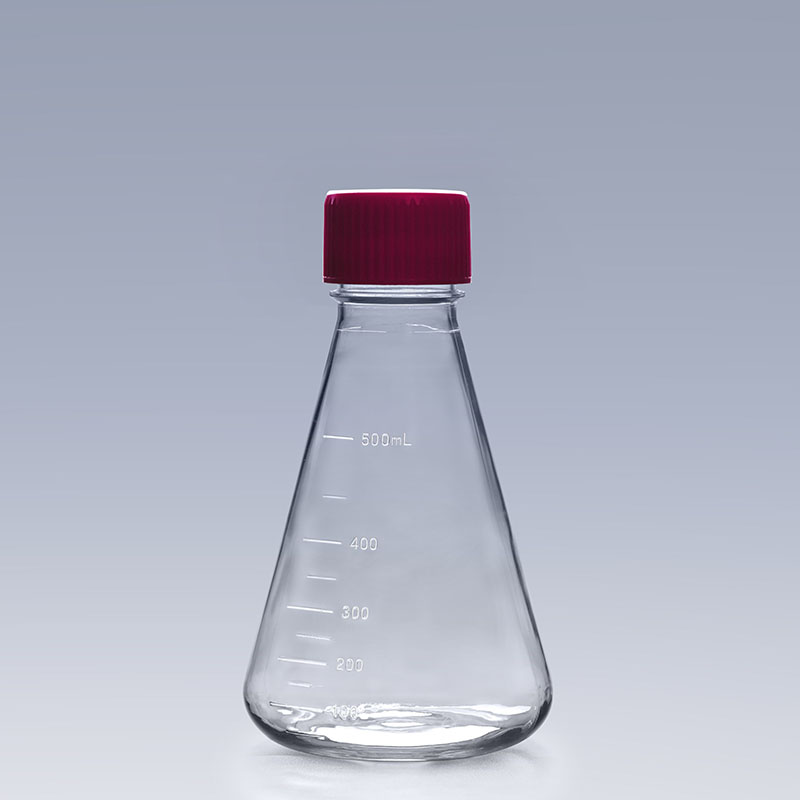As the core tool for suspension cell culture, cell shaker flasks are uniquely designed to effectively address the limitations of traditional culture vessels. Professional grade cell shaker flasks are made of medical polymer materials with excellent light transmission and gas exchange properties. The specially designed bottom structure of the flask creates an ideal vortex of liquid to ensure the uniform suspension and distribution of cells. Compared with ordinary culture flasks, its shock-resistant characteristics can be perfectly adapted to all kinds of shaker equipment, providing a continuous and stable growth environment for cells.
Guidelines for optimizing culture conditions
Successful suspension cell culture requires precise control of a number of parameters. The speed of rotation is the first consideration and is usually maintained in the range of 80-120rpm, depending on the cell type. The culture volume should be kept between 20-30% of the total volume to ensure sufficient space for gas exchange. Temperature control must be precise, and it is recommended to use a thermostatic shaker with temperature feedback to control fluctuation within ±0.5°C. Regular monitoring of glucose consumption and lactic acid accumulation can keep abreast of the cell metabolic status.

Professional Transfusion Operation Specification
When the cell density reaches 0.8-1×10^6 cells/mL, we can consider passaging operation. Direct passaging is suitable for cell populations in good condition, and requires preheating fresh medium to 37℃. For cells showing signs of aging, centrifugation is recommended, with centrifugal force controlled in the range of 100-150g for no more than 5 minutes. Regardless of which method is used, aseptic practices must be strictly enforced and the entire process must be completed in a biological safety cabinet.
In-depth analysis of common problems
Cell clumping is often related to media composition or culture conditions, and can be improved by optimizing rotation speed or adding 0.02-0.05 mM EDTA. Growth retardation may be due to insufficient nutrition or abnormal environmental parameters, it is recommended to carry out media composition testing and equipment calibration. Pollution prevention and control require the establishment of sound operational standards, including regular environmental monitoring and a strict personnel training system. For critical experiments, disposable culture systems are recommended to eliminate the risk of cross-contamination.
In conclusion, the importance of cell shaker as a basic tool for suspension cell culture should not be ignored. Mastering the correct use and understanding the solutions to common problems will help to obtain better culture results. With the advancement of technology, cell shakers will certainly play a greater role in the biopharmaceutical field.
The FAI climbed 5.9 percent year-on-year in the first 11 months of 2018, quickening from the 5.7-percent growth in Jan-Oct, the National Bureau of Statistics (NBS) said Friday in an online statement.
The key indicator of investment, dubbed a major growth driver, hit the bottom in August and has since started to rebound steadily.
In the face of emerging economic challenges home and abroad, China has stepped up efforts to stabilize investment, in particular rolling out measures to motivate private investors and channel funds into infrastructure.
Friday's data showed private investment, accounting for more than 60 percent of the total FAI, expanded by a brisk 8.7 percent.
NBS spokesperson Mao Shengyong said funds into weak economic links registered rapid increases as investment in environmental protection and agriculture jumped 42 percent and 12.5 percent respectively, much faster than the average.
In breakdown, investment in high-tech and equipment manufacturing remained vigorous with 16.1-percent and 11.6-percent increases respectively in the first 11 months. Infrastructure investment gained 3.7 percent, staying flat. Investment in property development rose 9.7 percent, also unchanged.
 English
English


















































